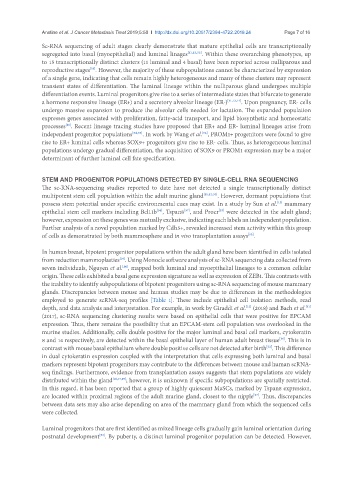Page 362 - Read Online
P. 362
Anstine et al. J Cancer Metastasis Treat 2019;5:50 I http://dx.doi.org/10.20517/2394-4722.2019.24 Page 7 of 16
Sc-RNA sequencing of adult stages clearly demonstrate that mature epithelial cells are transcriptionally
segregated into basal (myoepithelial) and luminal linages [11,12,53] . Within these overarching phenotypes, up
to 15 transcriptionally distinct clusters (11 luminal and 4 basal) have been reported across nulliparous and
reproductive stages . However, the majority of these subpopulations cannot be characterized by expression
[11]
of a single gene, indicating that cells remain highly heterogeneous and many of these clusters may represent
transient states of differentiation. The luminal lineage within the nulliparous gland undergoes multiple
differentiation events. Luminal progenitors give rise to a series of intermediate states that bifurcate to generate
a hormone responsive lineage (ER+) and a secretory alveolar lineage (ER-) [11,12,14] . Upon pregnancy, ER- cells
undergo massive expansion to produce the alveolar cells needed for lactation. The expanded population
expresses genes associated with proliferation, fatty-acid transport, and lipid biosynthetic and homeostatic
processes . Recent lineage tracing studies have proposed that ER+ and ER- luminal lineages arise from
[11]
independent progenitor populations [54,55] . In work by Wang et al. , PROM1+ progenitors were found to give
[54]
rise to ER+ luminal cells whereas SOX9+ progenitors give rise to ER- cells. Thus, as heterogeneous luminal
populations undergo gradual differentiation, the acquisition of SOX9 or PROM1 expression may be a major
determinant of further luminal cell fate specification.
STEM AND PROGENITOR POPULATIONS DETECTED BY SINGLE-CELL RNA SEQUENCING
The sc-RNA-sequencing studies reported to date have not detected a single transcriptionally distinct
multipotent stem cell population within the adult murine gland [11,12,53] . However, dormant populations that
possess stem potential under specific environmental cues may exist. In a study by Sun et al. mammary
[13]
epithelial stem cell markers including Bcl11b , Tspan8 , and Procr were detected in the adult gland;
[57]
[33]
[56]
however, expression on these genes was mutually exclusive, indicating each labels an independent population.
Further analysis of a novel population marked by Cdh5+, revealed increased stem activity within this group
of cells as demonstrated by both mammosphere and in vivo transplantation assays .
[13]
In human breast, bipotent progenitor populations within the adult gland have been identified in cells isolated
from reduction mammoplasties . Using Monocle software analysis of sc-RNA sequencing data collected from
[14]
seven individuals, Nguyen et al. , mapped both luminal and myoepithelial lineages to a common cellular
[14]
origin. These cells exhibited a basal gene expression signature as well as expression of ZEB1. This contrasts with
the inability to identify subpopulations of bipotent progenitors using sc-RNA sequencing of mouse mammary
glands. Discrepancies between mouse and human studies may be due to differences in the methodologies
employed to generate scRNA-seq profiles [Table 1]. These include epithelial cell isolation methods, read
depth, and data analysis and interpretation. For example, in work by Giraddi et al. (2018) and Bach et al.
[12]
[11]
(2017), sc-RNA sequencing clustering results were based on epithelial cells that were positive for EPCAM
expression. Thus, there remains the possibility that an EPCAM-stem cell population was overlooked in the
murine studies. Additionally, cells double positive for the major luminal and basal cell markers, cytokeratin
8 and 14 respectively, are detected within the basal epithelial layer of human adult breast tissue . This is in
[14]
contrast with mouse basal epithelium where double positive cells are not detected after birth . This difference
[22]
in dual cytokeratin expression coupled with the interpretation that cells expressing both luminal and basal
markers represent bipotent progenitors may contribute to the differences between mouse and human scRNA-
seq findings. Furthermore, evidence from transplantation assays suggests that stem populations are widely
distributed within the gland [16,17,19] ; however, it is unknown if specific subpopulations are spatially restricted.
In this regard, it has been reported that a group of highly quiescent MaSCs, marked by Tspan8 expression,
are located within proximal regions of the adult murine gland, closest to the nipple . Thus, discrepancies
[57]
between data sets may also arise depending on area of the mammary gland from which the sequenced cells
were collected.
Luminal progenitors that are first identified as mixed lineage cells gradually gain luminal orientation during
postnatal development . By puberty, a distinct luminal progenitor population can be detected. However,
[53]

